Heidi, Girl of the Alps (アルプスの少女ハイジ , Arupusu no Shōjo Haiji) is an animated series by Zuiyo Eizo (now Nippon Animation) that aired on Fuji TV every Sunday from 19:30 to 20:00 (JST) from January 6th to December 29th, 1974. It was directed by Isao Takahata, and features contributions from Yōichi Kotabe (character design, animation director), Toyoo Ashida (co-character design, animation director), Yoshiyuki Tomino (storyboard, screenplay), and Hayao Miyazaki (scene design, layout, screenplay). It was the sixth animated series made for the Calpis Manga Theater, and was preceded by Fables of the Green Forest (1973).
It is based on the 1880 Swiss novel Heidi's Years of Wandering and Learning by Johanna Spyri. The animation studio responsible for Heidi, Zuiyo Enterprises, would split in 1975 into Nippon Animation Company, Ltd. and Zuiyo Company, Ltd., which retained the rights (and debt) to the Heidi TV series.
The feature-length film edit of the TV series, released in March 1979, was engineered completely by Zuiyo, with no additional involvement from Nippon Animation, Takahata or Miyazaki.
Yamanashi Prefectural Flower Center: Heidi's Village, is a Heidi themed park located in Hokuto City.[1] A Heidi exhibition was held at the Ghibli Museum from May 2005 to May 2006. In 2019, Natsuzora paid tribute to Heidi.
Plot[]
Up The Mountain[]
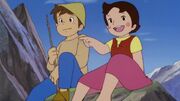
Heidi led a carefree life with Peter and her grandfather.
Heidi (short for Adelheid) is five years old when her aunt Dete, who has raised Heidi since her parents' (Tobias and Adelaide) deaths four years earlier, takes Heidi to live with her formidable grandfather in the Swiss Alps. Dete has found a promising job in Frankfurt, but cannot leave while still Heidi's guardian, nor can she take Heidi with her. The only relative left is Heidi's grandfather, and in Dete's opinion, he should take some responsibility. Alm-Onji (Alps-Uncle), as Heidi's grandfather is commonly known, has a fearsome reputation with the villagers of Dörfli, as rumors claim that in his youth he killed a man. Now he lives a solitary life with his dog Josef in a cabin halfway up the mountain. However, Heidi quickly wins her way into his heart with her enthusiasm and intelligence, firmly establishing herself in his life.
She spends her days on the mountain top with the goatherd Peter, whose responsibility it is to take the villagers' goats to the high mountains for pasture, and her winters occasionally visiting Peter's grandmother, a blind old woman whose dream is to one day hear her cherished book of psalms read to her. Alm-Onji's misanthropy and seclusion prevents Heidi from going to school, of which she has no experience anyway, ultimately leaving her illiterate.
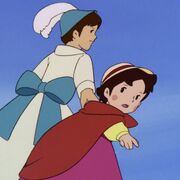
Heidi being taken away to the city by her aunt Dete.
Heidi continues to live happily in the mountains until Aunt Dete returns from the city, excited about a good opportunity for Heidi. A wealthy German businessman, Mr. Sesemann, is searching for a companion for his crippled daughter Clara. Thwarted by Alm-Onji, Dete tricks Heidi into accompanying her, ostensibly to get a present for Peter and her grandfather. Promised that she can return at any time, Heidi is taken to Frankfurt. There, Dete abandons her to the "care" of Miss Rottenmeier, the strict, no-nonsense governess in charge of Clara's welfare. Heidi and Clara quickly become friends, and Heidi quickly turns the household topsy-turvy with her escapades and well-meaning faux pas. Clara is enchanted by Heidi's stories of the Alps, which paint a picture of a life completely different from the sheltered and lonely one she is accustomed to. Her father is mostly away on business, and Clara's only constant companions until now are the servants and her canary.
Longing For Home[]

Heidi staring longingly at her home in the Alps.
Heidi's longing to return home and occasional attempts to escape are punctuated by the occasional distractions of new friends. She smuggles a small kitten into the house, and she and Clara care for it until Miss Rottenmeier discovers it and has it thrown out, until Sebastian, the kindly butler, is able to leave the kitten with a friend. Clara's doctor befriends her, and occasionally keeps a benevolent eye on her, but it is Clara's grandmother that has the most impact. On one of her rare visits to Frankfurt, she and Heidi become fast friends. Under her kindly tutelage, Heidi finally learns how to read, to the astonishment of the tutor who has struggled for months to do the same. However, the old woman's departure home again proves a turning point for Heidi. Forbidden by Miss Rottenmeier to ever mention or even think of the Alps again, Heidi rapidly goes into a decline, eventually becoming a sleep-walker, whose passage through the hallways is mistaken for that of a ghost, terrorizing the household.
Summoned home to deal with the haunting, Mr. Sesemann, with the aid of the doctor, catch Heidi in the middle of the night. The doctor diagnoses Heidi's condition and persuades Mr. Sesemann to send the girl back to her Alps before she dies of homesickness. Clara is only reconciled by the promise that she will be allowed to visit Heidi in her mountains. Under the care of Sebastian, Heidi embarks on the long trip home, finally returning to the arms of her overjoyed grandfather, Peter and his family.
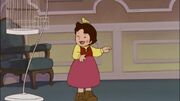
Heidi proved difficult to discipline.
Heidi's return and her newfound enjoyment of reading prompt Alm-Onji to partially restore a ruined house down in the village, where they retire the following winter so that Heidi can start going to school. Over the course of the season, Heidi and Alm-Onji become friendly with the villagers, and Peter builds his own sled and wins a local race. The subsequent spring, they return to the mountain in the Alps, bidding farewell to their new friends. In Frankfurt, Clara, who has been longing to see her friend again, reminds her father of his promise to her, but he reminds her that the conditions in the Swiss Alps may be too harsh for her to handle. The doctor is sent to the Alps in her place, to inspect the area and determine whether it is an appropriate environment for a crippled, sick young girl. Heidi, Peter, Alm-Onji, and the limitations of the terrain convince the doctor that this may be just the place for Clara to try her legs again.
All Is Well[]
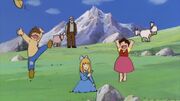
Heidi returns to the Alps with Clara and her family.
In due course, Clara comes to the Alps with Miss Rottenmeier, who shows a clear disapproval of the rustic conditions and an open fear of animals. However, Clara's grandmother soon arrives, and after seeing first-hand the vast improvement in Clara's condition, sends Miss Rottenmeier home, commending Clara to the Alm-Onji's care before departing herself. After having established that Clara's legs are capable of functioning, the children and Alm-Onji begin to work on Clara's physical therapy. Eventually, Clara is able to walk without assistance and returns home with her father and grandmother, promising that she will return the following spring to be with her friends again.
Behind the Scenes[]
Production[]
"I have come to feel a deep attachment to the landscapes of Europe."
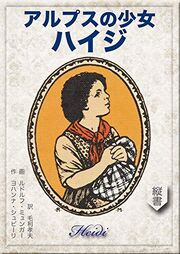
Cover for the new and complete Japanese edition of Heidi.
Heidi, Girl of the Alps is based on the novel of the same name by Swiss writer Johanna Spiri. The series continues to be rebroadcast across Japan well after the end of its original broadcast, and has character goods, commercials, and official parodies made to this day.
Prior to its production, Isao Takahata, Hayao Miyazaki, and Yoichi Kotabe traveled overseas to conduct location research. Takahata had initially wanted to adapt the story of Pippi Longstocking to the screen. But Swedish author Astrid Lindgren turned down the offer, saying she feared the Japanese director was interested "only in money", according to Yoichi Kotabe. So the director turned his attention to another classic of children's literature, and the team of Japanese animation artists headed to Switzerland to study Alpine cabins and pastures around the small eastern village of Maienfeld.[3]
In a special retrospective exhibition helf from September to October 2019 at the Swiss National Museum in Zurich, Yoichi Kotabe was invited to take part in the event to explain the genesis of the character he first began sketching nearly four decades ago.
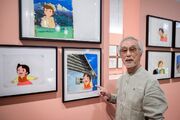
Kotabe in a special Heidi exhibition in Switzerland in 2019.
"The goal was to have a little girl who was 'kawaii', as cute as possible," he told the Associated Foreign Press, describing how he had first drawn her with large eyes, a big smile, but also "little braids". But he said that when he presented his first sketches, a specialist on the 1880 novel pointed out that "Heidi is a five year-old girl who lives in the mountains with her grandfather, who is not very friendly". "He is not going to do her braids every morning."
Kotabe was prompted to rethink her image and gave Heidi the ruffled, short, dark locks that fans of the series saw from the first episode in 1974. Although many adaptations of Heidi have been made for film and TV over the decades, Kotabe's version has thoroughly seeped into the public perception of the character.
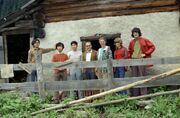
Hayao Miyazaki, Yoichi Kotabe and Isao Takahata standing in front of the mountain lodge which became the model for Heidi, Girl of the Alps in 1973.
During their research trip in Maienfeld, Switzerland, the team was under pressure. "This was entirely new for us," Kotabe said, pointing out that he had never been outside of Japan before. "The time was very short, so we were aware that we had to gather as much material as possible," he said, describing how the team had spent a month furiously sketching their surroundings. Takahata, who died in 2018 at the age of 82, was known for the realism of his animations and attention to detail in depicting ordinary life and nature.
Like its previous work Fables of the Green Forest, Zuiyo Enterprises, a subsidiary of Asahi Enterprise (planning and production), was responsible for the animation production. Shigeto Takahashi, the company's president, founded the company to create this work, and even before the production began, he produced a pilot for Heidi while he was a trainee in the planning department of the TCJ Video Center (now Aiken).
Years after Heidi aired, Nippon Animation became independent from Zuiyo Enterprises and acquired its production facilities and staff. They would go on to produce series under the World Masterpiece Theater banner, however Heidi was not included in its library. When Nippon Columbia released The Complete Collection of Theme Songs and Inserted Songs, from its World Masterpiece Theater, Heidi's songs were not included.
In 2000, a remake called The Girls Heidi and Clara in the Alps led by designer Michiko Sakurai, was being planned but later abandoned.
Reception[]
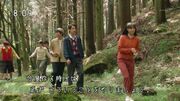
The 2019 NHK drama Natsuzora pays homage to Miyazaki, Takahata and Koibe's research trip to Switzerland. Unfortunately, Kotabe could not accompany the location scouting in Argentina and Italy for 3000 Leagues in Search of Mother due to back pain.
The series was widely broadcast in Europe, Africa, Asia and Arab countries. Kayeko Ikeda, a major fan of the series, was told by a German acquaintance that he "didn't think this was a work produced in Japan." Following this work, production teams for succeeding World Masterpiece Theater series conducted research trips abroad.
In 2010, August 12 was declared "Heidi's Day for The Girl in the Alps (Heidi's Day)" in Hiroshima by SanCreate Co., Ltd.
"The images of Heidi and her adventures in the mountains have had a strong impact on the Japanese, both young and old," Veronique Kanel, of Swiss Tourism. But she added that the series had also allowed "this image of Switzerland as a paradise of Alpine nature" to be spread around the world, drawing huge numbers of tourists to Heidi's remote valley.
Kotabe recalled how surprised he had been in the 1970s to see "no visible traces of Heidi" in Maienfeld. The TV series he helped create has changed that, with its success reflected in a dedicated Heidi museum, special hiking trail and souvenir shops. "Today, everything in Maienfeld has to do with Heidi," Kotabe said.[4]
Difference From Original[]
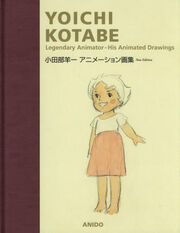
Artbook collecting Yoichi Kotabe sketches of Heidi.
The biggest change from the original by Isao Takahata is his treatment of Peter. In the original, Peter is depicted as being weak-willed and subordinate to Heidi, and as will be described later, there is a scene in which Clara's wheelchair is secretly dropped from the cliff and destroyed, feeling resentful that she could not be taken care of because of Clara. In many cases, author Spyri's work have had a female-dominated narrative, but Takahata reoriented it to a more male-dominated order.
Additionally, the religious color of the original is excluded as much as possible, but respected as a whole. It is said that the religious nature of the original was replaced by an almost religious appreciation of nature. According to Jean-Michel Wismer, the praise of nature is linked to the "tradition of Shinto".
Theme Song / Insert Songs[]
Opening Theme[]
"Tell Me"
- Lyrics- Eriko Kishida / Composition- Takeo Watanabe / Arrangement- Yoshi Matsuyama / Song- Kayo Ishu & Nelly Schwartz (Yodel)
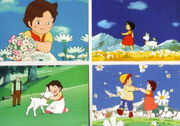
The charming imagery of the opening for Heidi.
The song begins with an Alpine horn and harp tones followed by a yodeling chorus. The opening scene cuts to the iconic scene of Heidi on a large swing against the backdrop of the majestic mountains of the Alps. In the lyrics, the song asks her grandfather who lives with her in the mountains about daily life.
The song features authentic yodeling and an Alpine horn recorded in Switzerland. Hidetoshi Kimura, the series' music director, said it was unheard of to spend a lot of money on an overseas recording for anime music. The accounting manager at Nippon Columbia chastised Kimura when he requested to visit Switzerland and refused to pay for his trip. Therefore, Kimura had to go to Switzerland with a mixing engineer on his own dime. The song became a massive hit and later, that same accounting manager became more receptive to Kimura's ideas.
The theme song's single sold 1.2 million copies in Japan and became a million seller in Europe. In 1974, the song won a special award at the FNS Music Festival.
Release[]
The series was released on home video by Bandai Visual (Bandai Media Division). The cumulative number of videos and DVDs shipped reached about 800,000 as of May 2003.
- In 1989, the VHS set was released in 13 volumes (4 episodes in each volume) since and 10 volumes in 1997 (5 episodes in each volume (6 episodes in volumes 1 and 2)).
- From August 25th to November 25th, 1999, a total of 13 volumes (4 episodes of each volume) were released, and the remastered DVD-BOX was released on November 26th, 2010. The latter also includes the crown image of "Calpis Manga Theater," which was cut in the VHS version and LD version.
Cast[]
TV version[]
- Heidi (ハイジ Haiji) - Kazuko Sugiyama (杉山佳寿子)
- Alm-Ohi (アルムおんじ Arumu onji) - Kōhei Miyauchi
- Peter (ペーター Pētā), Bakery owner (wife) - Noriko Ohara
- Großmutter (おばあさん Obasan) - Miyako Shima (eps 10-11)
- Großmutter (おばあさん Obasan), Village child - Terue Nunami
- Aunt Dete - Taeko Nakanishi
- Clara Sesemann (クララ・ゼーゼマン Kurara Zēzeman) - Rihoko Yoshida
- Miss Rottenmeier (ロッテンマイヤー Rottenmaiyā) - Miyoko Asō
- Sebastion (セバスチャン Sebaschan) - Kaneta Kimotsuki
- Mr. Sesemann (ゼーゼマン Zēzeman) - Taimei Suzuki
- Brigette - Akiko Tsuboi (eps 10-11), Takako Kondo (eps 12-52)
- Yak breeders - Akira Kamiya, Keaton Yamada
- Grandmamma - Natsuko Kawaji
- Bakery owner (husband), Shutoral - Eken Mine
- Church tower caretaker, Tsindel - Tetsuo Mizutori
- Pastor - Ichirō Nagai
- Shutoral's Mother - Kimie Nakajima
- Johann (ヨハン Johann) - Yoshiaki Nemoto
- Organ player boy - Masako Nozawa
- Village child - Keiko Yamamoto
- Linda (ep 42), Narrator - Toshiko Sawada
- Villager - Michiko Saegusa
- Klara's tutor - Akira Shimada
- Hunter in black (ep 11) - Ryouichi Tanaka
- Tinette - Noriko Tsukase
- Hunter in white (ep 11), Thomas (ep 1) - Kouji Yada
- Landlord - Jōji Yanami
- Additional Voices
- Yoshiaki Nemoto
- Sumie Ozawa
- Miyoko Shoji
Movie version[]
| Character | Original | English |
|---|---|---|
| Heidi (ハイジ Haiji) | Kazuko Sugiyama (杉山佳寿子) | Randi Kiger |
| Alm-Ohi (アルムおんじ Arumu onji) | Kōhei Miyauchi | Vic Perrin |
| Peter (ペーター Pētā) | Hiroko Maruyama | Billy Whitaker |
| Großmutter (おばあさん Obasan) | Terue Nunami | Irene Tedrow |
| Aunt Dete | Taeko Nakanishi | Janet Waldo |
| Clara Sesemann (クララ・ゼーゼマン Kurara Zēzeman) | Keiko Han | Michele Laurita |
| Miss Rottenmeier (ロッテンマイヤー Rottenmaiyā) | Hisako Kyōda | Jacquelyn Hyde |
| Sebastion (セバスチャン Sebaschan) | Kaneta Kimotsuki | Alan Reed |
| Mr. Sesemann (ゼーゼマン Zēzeman) | Taimei Suzuki | Barney Phillips |
| Brigette | Akiko Tsuboi | Julie McWhirter |
- Additional Voices
- Original: Mitsuo Senda (Johann (ヨハン Johann))
- English: Julie McWhirter (Neighbor Lady), Vic Perrin (The Doctor, Postman), Barney Phillips (Mr. Kaehlin), Alan Reed (Mr. Usher), Lurene Tuttle (Clara's Grandmother)
References[]
External Links[]
Official Sites
- Heidi, Girl of the Alps Official Homepage
Information
 Heidi, Girl of the Alps at the Internet Movie Database
Heidi, Girl of the Alps at the Internet Movie Database  Heidi, Girl of the Alps on Anime News Network
Heidi, Girl of the Alps on Anime News Network
- Heidi, Girl of the Alps on Wikipedia
Exhibitions
[]
| |||||||||||||||||||
|}
